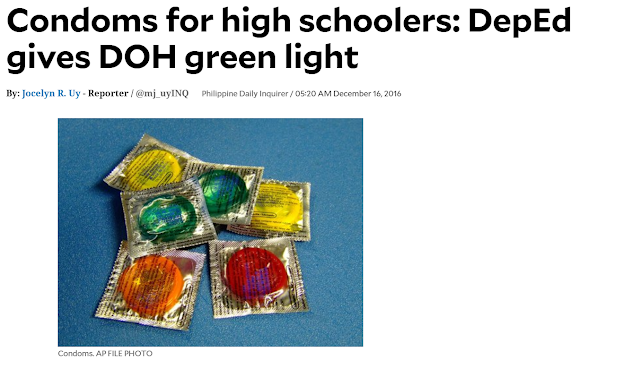Condoms in School
Providing condoms in schools is controversial. Opposition is often cast in terms of the right of parents to educate their children about moral and religious values. Of course, there is really no school program that takes this right away from parents and giving out condoms in schools certainly does not take a parent's right to educate his or her child about sexual abstinence. Thus, the real opposition seems rooted in a perception that making condoms available in schools encourage sexual promiscuity. In the Philippines, plans to distribute condoms in public high schools are currently underway.
The move is prompted by rising cases in AIDS in the country. Close to ninety percent of these cases involve males having sex with males. A majority of the cases suggests that the rising cases involve individuals who are not in high school (25 years of age or older). If the purpose of making condoms available in school is to curb the rising number of cases of sexually transmitted diseases, the AIDS data do not seem to support this action. It appears that the problem may be better addressed in college.
Condoms are recommended not just for protection against diseases. Condoms are of course effective in preventing unwanted pregnancy. So, perhaps, the planned condoms in schools program in the Philippines is also aimed at curbing teen pregnancies. How effective condoms are in reducing teen pregnancies, however, is still debatable. Recent research suggests that condoms in schools actually do the opposite:
DepEd does clarify that the program it envisions will involve counseling. The question of whether they are targeting the right segment of the population, however, remains to be addressed. With a high incidence of school leavers, teen pregnancy may be strongly correlated with dropouts and poverty. Giving condoms plus counseling may not help in this case. For this, increasing the quality of education maybe the only way to address the problem.
 |
| Above copied from Inquirer |
Condoms are recommended not just for protection against diseases. Condoms are of course effective in preventing unwanted pregnancy. So, perhaps, the planned condoms in schools program in the Philippines is also aimed at curbing teen pregnancies. How effective condoms are in reducing teen pregnancies, however, is still debatable. Recent research suggests that condoms in schools actually do the opposite:
The Incidental Fertility Effects of School Condom Distribution Programs
Kasey S. Buckles and Daniel M. Hungerman
NBER Working Paper No. 22322
June 2016
JEL No. J13
ABSTRACT
While the fertility effects of improving teenagers’ access to contraception are theoretically ambiguous, most empirical work has shown that access decreases teen fertility. In this paper, we consider the fertility effects of access to condoms—a method of contraception not considered in prior work. We exploit variation across counties and across time in teenagers’ exposure to condom distribution programs in schools. We find that access to condoms in schools increases teen fertility by about 10 percent. These effects are driven by communities where condoms are provided without mandated counseling.
DepEd does clarify that the program it envisions will involve counseling. The question of whether they are targeting the right segment of the population, however, remains to be addressed. With a high incidence of school leavers, teen pregnancy may be strongly correlated with dropouts and poverty. Giving condoms plus counseling may not help in this case. For this, increasing the quality of education maybe the only way to address the problem.
Comments
Post a Comment